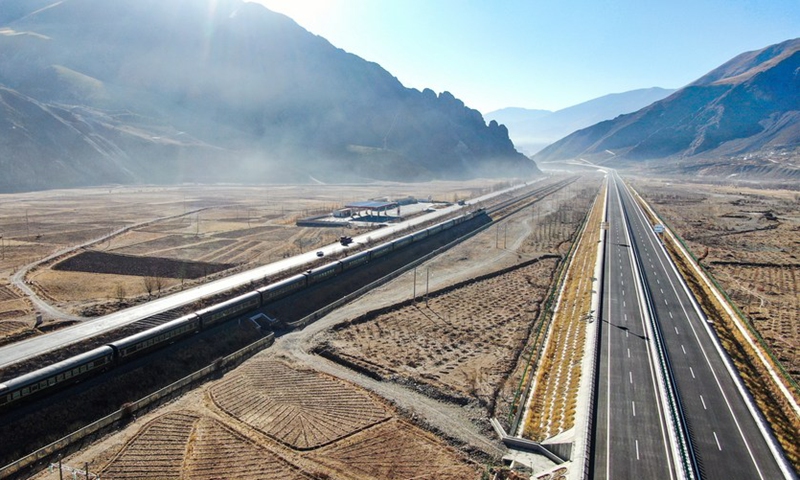
Aerial photo taken on Jan. 28, 2021 shows a section of the Lhasa-Nagqu high-grade highway (R) and the Qinghai-Tibet railway in southwest China's Tibet Autonomous Region. (Photo: Xinhua)
The China-South Asia freight train service linking Haidong, Northwest China's Qinghai Province and Nepal has been launched, beefing up the country's ever-expanding rail freight network, which has made the China-Europe freight train service a calling card of the country's logistics prowess despite the pandemic.
The first train departed from a railway freight yard in Haidong on Wednesday. The 30-car train, carrying some 1,350 tons of supplies, including everyday items and farm byproducts, set out for Xigaze, Southwest China's Xizang Autonomous Region, the Tibet Daily said in a post on its WeChat official account on Thursday.
The goods will then be transported by road and exported in batches before eventually reaching their final destination - Kathmandu, the capital of Nepal, according to the report, sketching out a journey of about 2,800 kilometers that would supposedly take six days.
The first such cargo service that combines rail and road transportation was launched by Qinghai Province and the China Railway Qinghai-Tibet Group Co, per the Thursday report, revealing that Qinghai-Tibet Group has plans to strengthen the development of plateau railways, expand the rail network and take full advantage of rail transport, known for its high speeds, large volumes and low costs, for there to be increased international freight train capacity.
The China-South Asia freight train service adds to the country's international cargo supply chain strength revolving around robust freight train services connecting China and Europe.
Since the launch of the China-Europe freight train service in 2011, the number of trains running between China and Europe topped 10,000 for the first time in 2020, up sharply from a mere 17 during the first year, the Securities Daily reported in November.
In the first 10 months of this year, the number of China-Europe freight trains hit 12,605, an increase of 26 percent year-on-year. The freight trains carried 1.22 million 20-foot equivalent unit containers of goods during the period, a rise of 33 percent from the year before, data from the report showed.
This suggests that both the number of trains and the volume of their cargoes exceeded that for the whole of last year, arguably an indication of the country's role as a ballast to international logistics supply chains.


